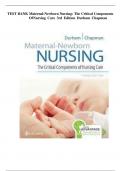Exam (elaborations)
Test Bank: Maternal-Newborn Nursing: The Critical Components of Nursing Care, 3rd Edition, Roberta Durham, Linda Chapman
- Course
- Institution
- Book
Test Bank: Maternal-Newborn Nursing: The Critical Components of Nursing Care, 3rd Edition, Roberta Durham, Linda Chapman Test Bank: Maternal-Newborn Nursing: The Critical Components of Nursing Care, 3rd Edition, Roberta Durham, Linda Chapman Test Bank: Maternal-Newborn Nursing: The Critical Compone...
[Show more]



